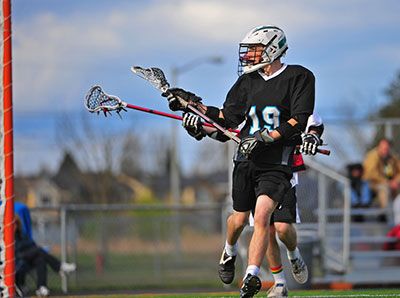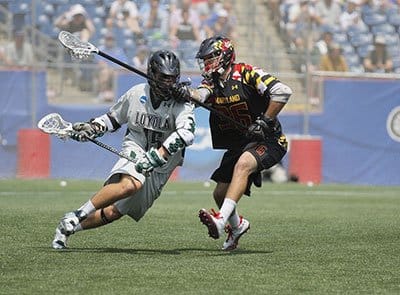Knowing the difference between over and back violations can be difficult, but with this comprehensive guide, you'll find all the necessary information!
We'll cover what lacrosse over and back violation is, when it occurs, and how it impacts both teams – as well as review examples of how players should act to avoid these violations.
With this knowledge under your belt, you can play without fear of committing an unintentional violation.
More...
Take away key points:
When unsure about the lacrosse rules for the over-and-back violation, please refer to the guide below to help you find all the vital information for a bigger picture.
What is an over-and-back violation in lacrosse?
The over-and-back violation occurs whenever the offensive team returns the ball over the midfield line after clearing it.
Once the offensive team enters the attack area, the shot clock will begin. Therefore, the offensive team will have to either keep the ball inside the attack area until the shot clock runs out or score a goal.
However, the team will commit the over-and-back violation when the offensive team is forced back over the midfield line or passes the ball intentionally into the defensive half.
What is the over-and-back rule in lacrosse?
When in the offensive half of the lacrosse field, the ball must not return to the team in the defensive half through their actions and moves. If such a situation appears, the outcome will be an over-and-back violation of lacrosse rules.
What are the exceptions to the over and back rule?
There are two exceptions to the over-and-back rule violation. These include shot and tip.
First, if the ball was last touched by a defensive team or a shot, there will not be any violation of the rules.
A shot is considered a ball propelled toward the goal parallel to or a goal line extended and made by the offense with the intention of scoring the goal.
When can a ball return safely to the defensive half of the field?
The lacrosse ball can only return safely to the defensive half of the field after a valid offensive shot or after the changed ball possession. Therefore, a valid shot missing the goal and returning to the defensive zone does not include a violation of rules.
Moreover, there is no infraction of the rules if the ball does not pass or touch midline before the offense player bats or pulls back into the offensive end, including the player outside the offensive end of the field.
Any defender can use their lacrosse stick to bat the ball and keep it inside the offensive zone, but the defender will violate the rules if he gains possession over the midline - their defensive zone. The violation will not occur when the ball leaves the offense as a result of the defensive player.
How does an offensive player violate the over-and-back rules?

To score a goal, the offensive player from the offensive team currently in possession of the ball must clear the ball through the defensive zone and enter the opposing team's offensive half. There, the player and the team in general try to pass by the defensive players to shoot at the goal.
Similarly to basketball, the boys' lacrosse rules require an offensive player to enter the offensive half of the opposing team to score, and once he does, the eighty-second shot clock begins.
Once the shot clock runs less than sixty seconds, the offensive players must either score or keep possession of the ball in the attack area until the time runs out. However, if the team doesn't score and returns the ball to the defensive side over the midfield line, the over-and-back violation occurs.
The over-and-back violation has that name as the lacrosse ball crosses the midline of the lacrosse field, enters the offensive side, and then crosses the midline again to return to the defensive end of the field before the shot clock ends.
Is the over-and-back violation a technical foul or a personal foul?
Over-and-back rule violations are minor infractions considered technical fouls. They do not include unsportsmanlike conduct, illegal body-checking, aggressiveness, unnecessary roughness, etc., that are considered personal fouls and are physically directed against an opposing player.
Ultimately, lacrosse players should be aware of the rules and respect such guidelines to avoid any unnecessary calls from officials, and the play resumes after the warning.
Different types of over-and-back lacrosse penalties
An offending team commits various types of this violation. Let's learn some of them.
For instance, an offensive player can stand in the goal area with the possession of the ball, and he passes the lacrosse ball to his team member to avoid the defensive players of team B. This is called a deliberate over-and-back violation.
A violation of lacrosse rules may also occur when an offensive player with the ball possession enters the attacking area but is checked backward midfield by the defensive team while he still has the ball.
Examples of the over and back penalties
Here are some of the most common examples of boys' lacrosse rules violations. Some of them include:
- The second team makes a defensive play and makes an errant pass into the defensive zone of the first team. However, the first team regains the ball possession and crosses back to the offensive side, but an offending player sends the ball back to their defensive zone across the center line. The referee stops playing, and the second team gains the ball.
- A player from the first team has the ball in the offensive end, and the shot clock is under sixty seconds. He passes a ball, but an offending player of the opposing team touches the ball and makes the ball touch or cross the center line. The third player from the first team picks the ball in the defensive zone. The defensive player sent the ball from the offense, and there is no violation. But, if the third player enters the offense, the ball cannot return to the defensive zone without the rule violation.
- One player has the ball in the offense and wants to pass to his team member. However, the teammate fails to receive the ball, and it rolls toward the center line. The third teammate standing in the defense bats the ball to prevent it from crossing the midline. As the ball did not cross the line, there is no rule violation.
What is the punishment for the violation of the over-and-back rules?

In youth lacrosse and NCAA men's lacrosse, violating the over-and-back rule includes two punishments for the offending team. The first punishment is an immediate change of the ball possession going to the other team - the defensive team B.
The second punishment includes a quick restart for the defense, and one defensive player will gain possession in bounds, start in a stationary position, and the play will resume. Again, these rules are the same for the NCAA and youth levels.
How will the referee signal an over-and-back violation?
There is no official signal the official can use for the rule-breaking. However, as technical fouls usually result in a change of possession, the official will make a sign for altering possession.
The referee will bend his elbow and place both palms over his stomach with his fingertips touching. Then, he will point to the other team's side that regains possession with the appropriate arm.
Another signal the referee might show is similar to a false start in football. Finally, the official might signal an illegal procedure by placing both of his arms crossed in front of his chest and rotating them around one another.
What happens if a team scores during the over-and-back violation?
If a team scores while committing this violation, the goal is nullified, and play resumes with a turnover at the spot of the violation. This penalty is in place to ensure teams are playing fair and not gaining an unfair offensive advantage.
Although it can be hard for a team who believes their hard work has paid off at a point, all players must understand and accept this rule to keep the game balanced and fun.
Similar violations to over and back violation
We have included some of the most similar rules-breaking methods to an over-and-back violation in lacrosse. These include: illegal touching of the ball, illegal procedure, and illegal body check.
Illegal touching of the ball
Illegal touching of the ball refers to the situations in which lacrosse players touch the ball with their hands, even though they are not allowed to do so. Players must use their lacrosse sticks when making contact with the ball.
There is only one exception to this rule. A goalie can use his hands on the crease to prevent the ball from going into netting when in the crease line.
Illegal procedure
An illegal procedure in lacrosse is a term that describes various circumstances in which the game is stopped or delayed.
Such methods include an offending player entering the field before the time remaining for the penalty is run out, delaying too many players at the specific half of the lacrosse field at a specific moment, delaying the game and play, touching the ball with hands, failing to advance, etc.
Illegal body check
Other fouls, including an illegal body check, hitting the opponent's head or neck, aggressiveness, pushing, etc. are considered major infractions. Therefore, all players committing such an offense will receive stricter punishments for unfair play.
Final verdict
While the lacrosse over and back violation is not a major infraction, it can still affect the game and the team's overall performance.
Following the rules and understanding the concept better can take your game to the next level.
